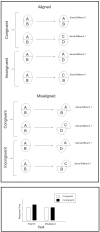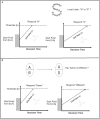Navon letters and composite faces: same or different processing mechanisms?
- PMID: 38023009
- PMCID: PMC10652416
- DOI: 10.3389/fpsyg.2023.1219821
Navon letters and composite faces: same or different processing mechanisms?
Abstract
Navon letters and composite faces are two fascinating demonstrations of hierarchical organization in perception. Many researchers believe that the two types of stimuli and their associated tasks gauge comparable holistic mechanisms. This belief is so common that the two paradigms are now being applied in tandem to measure impaired holistic processing in prosopagnosic patients. But are Navon letters and composite faces processed in a similar fashion? In the present study we take a closer look at their apparent affinity. We gain novel insights into their underlying mechanisms by fitting parameters of the linear ballistic accumulator (LBA) model to empirical correct and incorrect response times (RTs). The results reveal major differences in processing between the two tasks. We conclude that despite the presence of a compelling surface similarity, Navon compound letters and composite faces tap into separate psychological processes.
Keywords: LBA; Navon letters; composite face illusion; face recognition; holistic processing; response time models.
Copyright © 2023 Fitousi and Azizi.
Conflict of interest statement
The authors declare that the research was conducted in the absence of any commercial or financial relationships that could be construed as a potential conflict of interest.
Figures









Similar articles
-
Priming global and local processing of composite faces: revisiting the processing-bias effect on face perception.Atten Percept Psychophys. 2011 Jul;73(5):1477-86. doi: 10.3758/s13414-011-0109-7. Atten Percept Psychophys. 2011. PMID: 21359683 Free PMC article.
-
Same, same—but different: on the use of Navon derived measures of global/local processing in studies of face processing.Acta Psychol (Amst). 2014 Nov;153:28-38. doi: 10.1016/j.actpsy.2014.09.004. Epub 2014 Oct 1. Acta Psychol (Amst). 2014. PMID: 25282198
-
A spatial frequency account of the detriment that local processing of Navon letters has on face recognition.J Exp Psychol Hum Percept Perform. 2009 Oct;35(5):1427-42. doi: 10.1037/a0015788. J Exp Psychol Hum Percept Perform. 2009. PMID: 19803647
-
The influence of visual and phonological features on the hemispheric processing of hierarchical Navon letters.Neuropsychologia. 2018 Jan 31;109:75-85. doi: 10.1016/j.neuropsychologia.2017.12.013. Epub 2017 Dec 9. Neuropsychologia. 2018. PMID: 29233717
-
The composite face illusion.Psychon Bull Rev. 2017 Apr;24(2):245-261. doi: 10.3758/s13423-016-1131-5. Psychon Bull Rev. 2017. PMID: 27488558 Review.
Cited by
-
Sequential Effects on Reaction Time Distributions: Commonalities and Differences Across Paradigms.J Cogn. 2024 Sep 3;7(1):68. doi: 10.5334/joc.395. eCollection 2024. J Cogn. 2024. PMID: 39246695 Free PMC article.
-
Capacity and architecture of emotional face-ensemble coding.J Vis. 2025 May 1;25(6):10. doi: 10.1167/jov.25.6.10. J Vis. 2025. PMID: 40423625 Free PMC article.
-
The quest for psychological symmetry through figural goodness, randomness, and complexity: A selective review.Iperception. 2024 Feb 14;15(1):20416695241226545. doi: 10.1177/20416695241226545. eCollection 2024 Jan-Feb. Iperception. 2024. PMID: 38361502 Free PMC article.
References
LinkOut - more resources
Full Text Sources
Miscellaneous

